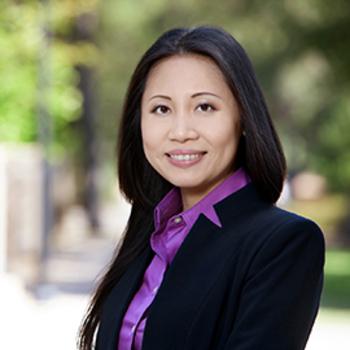The following ideas are highlights from the Faculty Showcase on Cultivating Diversity, Equity, and Inclusion (DEI) in the GSB Classroom held on April 13, 2022. GSB Amplifier Award nominees and recipients Szu-chi Huang, Jann Spiess, and Kate Casey shared these strategies and tips from their work in building equitable and inclusive classrooms.
Faculty Showcase Presentations
- Associate Professor of Marketing Szu-chi Huang, who teaches a marketing course and runs the Stanford-Tsinghua Exchange program, shares her strategies for inviting and framing the value of diverse perspectives. She also discusses inclusive grading models for participation and the value of building offline personal relationships. Watch Szu-chi’s presentation.
- Assistant Professor of Operations, Information & Technology Jann Spiess shares examples of how he integrates DEI-related content into a core quantitative flipped course focused on data-driven decision making. He also suggests acknowledging positionality and bringing in levity as helpful strategies when one is struggling with discussing DEI-related topics in the classroom. Watch Jann’s presentation.
- Associate Professor of Political Economy Kate Casey discusses strategies for getting everyone involved early in class participation, especially in her large (about 80 students) core course for MBA1 students. She also shares her approaches to productively framing discussions of sensitive topics. Watch Kate’s presentation.




Inviting Productive Disagreement and Diverse Perspectives
Framing productive disagreement and inviting diverse perspectives in the classroom can be challenging. Showcase faculty shared their approaches:
- Highlight what is gained by hearing different perspectives in terms of variance and averages.
“[I explain to students that] when we look at numbers we often focus on the average, but when we do that we miss so much information, because the variance is really the most important part that helps us interpret how reliable the average is. When we are discussing these difficult topics, we often try to look for an average, that we all agree on something–but by hearing different voices, we’re actually mapping out the variance….For R&D students, that usually clicks. It’s about plotting [and understanding] the data set, rather than finding the average and being comfortable with one number.” (Watch Szu-chi Huang.)
- Explicitly separate positive and normative discussions. Problems sometimes arise when positive arguments are misconstrued as normative ones, and maintaining clear parallel tracks creates space for contradiction and disagreement (watch Kate Casey). When things get heated, it can be helpful to steer the class to positive arguments (e.g., asking, “what can this data really tell us?”) (watch Jann Spiess).
- Normalize voicing counterarguments by focusing on the issue rather than the person. When a particular perspective is getting a lot of airtime in class discussion, ask someone to build a counterargument to a specific idea. This could also take the form of a point-counterpoint debate, assigning students sides that represent the real-world stakeholders in an issue (watch Kate Casey).
For additional strategies on handling sensitive discussion topics, see Handling Planned or Unexpected Class Discussions Involving Sensitive Topics.
Empowering Diverse Participation and Cultivating Inclusion
Jann, Kate, and Szu-chi shared strategies they employ for empowering diverse students to participate and cultivating inclusion in the classroom:
- Integrate DEI content. Use case studies that highlight diverse decision-making contexts–with the goal of fostering leaders who make decisions based on data but are sensitive to the data’s context (watch Jann Spiess). Highlight contributions of women and underrepresented minorities to your field as relevant to the course (watch Jann Spiess). Seek out diverse guest speakers, and incrementally build out content related to the expertise of those speakers (watch Kate Casey).
“[When] making decisions based on data, which sounds like a boring objective statistical exercise, there’s actually a lot of context…and a lot of responsibility in navigating that context. I want to turn people into effective leaders that acknowledge that context, and are sensitive to the issues that arise when you make decisions based on data.” (Watch Jann Spiess.)
- Reduce stress and encourage all students to participate. Use “warm calling” instead of cold calling: use a random number generator to choose students for each session, but post questions on Canvas in advance so that students can prepare (watch Kate Casey); make plans with students to call on them based on their interests and goals (watch Szu-chi Huang here and here). Track participation and reach out to students who are regularly quiet (watch Kate Casey).
- Get to know students. Have students fill out a survey indicating their experience and expertise with syllabus topics; you can provide students with airtime in class accordingly (watch Kate Casey here and here). Set up or invite one-on-one meetings (office hours, coffee hours, etc.) with students to get a sense for the variety of student backgrounds, participation comfort levels, and goals or interests in the course; this can also inform student airtime (watch Szu-chi Huang here and here).
- Set the tone early. Highlight the role of bringing diverse student backgrounds into discussion on the first day (watch Szu-chi Huang), including the discomfort and growth to which this will lead (watch Szu-chi Huang). Employ discussion strategies that get everyone involved during the first two weeks or so to set a precedent for classroom participation (watch Kate Casey).
“I try to get everyone ‘on the board’ [to have made at least one comment] in the first few sessions, maybe by session four…The idea is that once you speak once, it’s a little bit easier to speak a second time–a break-the-ice idea. It’s also about habit formation; once you get into that habit [of being silent in class], it’s really hard to break out of it. So I try to disrupt those habits from the beginning.” (Watch Kate Casey.)
For more classroom strategies based on Spring 2022 faculty presentations and student panel events, see Cultivating diversity, equity, and inclusion in the GSB classroom.
